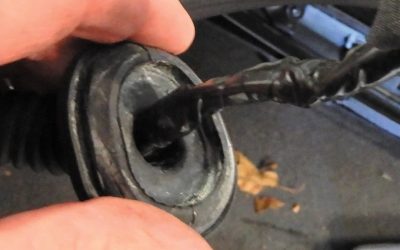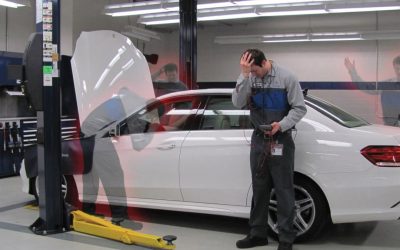Last time, we went deep into voltage checks. In this installment, we’ll look at testing amp output, and how it can tell you something Important about the battery, too.
By Vince Fischelli
In the last issue of Master Technician, we discussed the proper way of testing the charging voltage (“E”) on the car and under what conditions the charging voltage varies. In Part 2, we’ll focus on testing the charging current (“I”), which is completely different.
Figure 1 illustrates our basic charging system diagram again. The generator and battery are connected together just as they are on the vehicle. The car’s electrical system current load is represented by the box on the left connected between B+ (voltage) and B- (ground G201, G202 and G203).
Figure 2 illustrates how generator/charging current (“I”) flows through the car’s electrical system. Notice negatively charged electrons are represented as tiny circles with a negative sign inside. They are arranged to indicate the electron current flow through the circuit. Electron current always flows from the negative (or B-) terminal, through the circuit to the positive (B+) terminal. Total electron current leaves the generator’s negative terminal (B-) and “channels” through the engine block to the engine ground. Generator charging current travels up the engine ground cable, which is connected (grounded) to the engine block.
At the battery negative post, generator charging current splits into two different paths. One path supplies battery charging current. The other path supplies the car’s electrical system. A small electron current through the battery recharges it, and exits the battery positive terminal to return to the B+ terminal of the generator to complete the battery charging current circuit. This is called “battery charging current.”
A second electron current enters the accessory ground cable connection at the battery negative post and generator electrons flow down the accessory ground to enter the sheet metal, then “channel” through the sheet metal and travel up every sheet metal-grounded electrical circuit. In Figure 2 this is represented by G201, G202 and G203. Electron current flows through these grounded electrical circuits and returns to the generator B+ terminal, completing the electrical circuit. By the way, the ignition switch is always drawn OPEN in a schematic, so mentally CLOSE the switch to see the complete path for electron current back to B+.
Charging “Pressure”
The generator is the current source for all the electrical loads in the vehicle when the generator is performing normally. This means it is producing sufficient electron current to meet all electrical load demands while maintaining the charging voltage within the normal range of 13.8-14.8V. This voltage range is necessary for the battery to charge at the proper rate. That’s why you need to know what the charging voltage is and not just the charging current. It takes voltage to push electrons through the battery to recharge it, so don’t overlook the charging voltage.
Do not get charging voltage (“E”) and charging current (“I”) confused, as many do. This confusion results in a lot of misunderstanding in diagnosing charging system problems. Many technicians remain in doubt as to how to properly check the system, and two schools of thought have emerged. Each school seems to be very adamant in its way being the right way, period, end of discussion.
One school of thought says to check the charging voltage (“E”), and that’s all you have to do — don’t sweat the charging current! We thoroughly covered testing the charging voltage in Part I, so you now know how important it is. But don’t dismiss testing the charging current (“I”). It’s also important for a very good reason, which we will explain. We’ll also show the right way to test the charging current and why. Read on.
Meltdown
The opposite school of thought, the “current is best techs,” say to hook up a load tester to the battery terminals with the engine running and adjust for a heavy load using the carbon pile to see how much current the generator can produce, and don’t sweat the voltage! This is shown in Figure 3. Some say this is the only way to check a charging system. Whoa, “Podna!!” (Podna is how we say Dude!! in Texas). But first let’s debunk the load tester concept.
The idea of a load tester pushing a generator to its upper current limit, as shown in Figure 3, is not a valid test of the charging system for all conditions under which the charging system is required to perform. Furthermore, the generator is being dangerously stressed to its maximum limit of high current. What does high current do to generator temperature? It rises dramatically, causing the diode bridge to get much hotter than it should, which could potentially knock out a marginal diode bridge and create an unnecessary generator failure. It only takes a moment of high current for this destruction to occur.
As you can see in Fig 3, the carbon pile’s test leads are connected to the battery terminals. With the engine running at about 2,000 to 2,500 rpm, the carbon pile is engaged to draw current from the generator while the current is monitored on the ammeter. A generator is expected to actually produce about 90% of its rated output. Thus, a 120 amp alternator would be expected to produce about 108 amps when pushed to the max.
What does load current testing the generator reveal, and what doesn’t it reveal? You’d better know the answers to these questions so you don’t fall for either of the erroneous schools of thought about testing generators. Load testing the generator reveals how much current (“I”) the generator can develop at maximum loading, but nothing about the charging voltage (“E”) is known at that moment — it could be too low to pass a charging voltage test. Besides, a generator in normal operation doesn’t operate at maximum load unless there’s an electrical system fault or a momentary or an unusual driving condition.
Guess what! Both schools of thought are wrong in that each often dismisses or overlooks the other test. To properly test the charging system, (1) the charging voltage and, (2) the charging current should both be tested, period! But, when generator current is tested it has to be done the right way and for the right reason.
Charging System Basic CURRENT Concepts
Generator current testing should be performed while the generator is on the car. Expensive test equipment or a carbon pile is not needed. All you need is a DMM and a DC current clamp capable of reading from 1.0-200 amps (or more). With a DMM and current clamp and a little knowledge of what to look for, you are good-to-go to properly test the system for proper charging current.
Before we get to testing, we should review charging current basics by asking some questions. This will give you an opportunity to evaluate your knowledge of charging system operation as it relates to generator charging current (“I”).
Write your answers after each of the five questions before you read the rest of the article:
Question #1: What effect does high electrical load have on generator output current (“I”) and generator temperature?
Question #2: What effect does low electrical load have on generator output current (“I”) and generator temperature?
Question #3: Generator/battery charging current (“I”) will increase or decrease as the battery charges up?
Question #4: What are the two determining factors of battery charging current (“I”)?
Question #5: Three generators have been installed on the same vehicle in the past several days and all three generators have gone dead in about one day of driving. What is the first thing to check immediately after installing generator number 4?
Gotcha’ Thinking?
The following answers amount to explanations that should help illuminate any dark corners in your understanding:
Answer #1: High electrical load increases generator output current to supply current to all electrical loads. Generator heat increases dramatically.
Answer #2: Low electrical load lowers generator output current, and generator heat stays low.
Answer #3: Battery charging current will decrease as the battery recharges. Internal battery resistance rises as the battery charges up. If battery internal resistance increases, charging current begins to decrease until it holds fairly steady at, in most cases, less than 10 amps. This is called “battery steady-state current,” which maintains the battery’s state of charge.
Answer #4: The two factors that determine battery charging current are battery state of charge and internal battery resistance. Both increase as the battery charges, which lowers the charging current through the battery. It’s a rule: Anytime resistance increases, current decreases.
Answer #5: If a vehicle has a history of generator failures, it may indicate that the battery is at fault. Check battery charging current. There should be a gradual decrease in battery charging current until a steady-state battery current reading is obtained of less than 10 amps (on the average) in five minutes of engine idle. A battery’s steady-state current remains a load on the generator when the battery is fully charged and the engine is running. The lower the battery steady-state current is, the better. Low steady state current places a lower electrical load on the generator.
In addition to battery steady-state current, the current load on the generator increases when the engine is running and electrical loads are switched on, such as headlights, AC high blower, radio, w/wipers, etc. If battery steady-state current is too high (more than 20 amps) it causes an excessive load on the generator that results in overheating. This leads to premature generator diode bridge failure.
If battery charging current stays high after five minutes with the engine running, the battery is likely to be defective even though it may have no difficulty starting the engine or passing a load test. Both starting the engine and a load test verify how well current comes OUT of the battery, but we are concerned about how well current goes INTO the battery while it is charging – a completely different parameter.
Figure 4 shows a DC current clamp measuring charging current in the engine and accessory ground cables while the engine is running. Notice the placement of the current clamp around both the engine ground and the accessory ground at the same time. There is a reason for this.
Total generator current leaves the generator’s negative terminal (the generator housing), channels through the engine block, travels UP the engine ground cable to where it splits between the battery and the vehicle loads. Some current flows through the battery to charge it up. The rest of the current flows DOWN the accessory ground cable, channels through the sheet metal and enters the electrical system through the three ground connections, G201, G202 and G203 and others that might be present.
What this means is total electrical current flows UP the engine ground cable and electrical system current flows DOWN the accessory ground cable. The DC current clamp samples the current in both wires at the same time, but the two currents are flowing in opposite directions. The resultant reading is the difference between the two currents, which just happens to be the current flowing through the battery. It is battery charging current that we are interested in determining. Total generator charging current minus the current flowing through the electrical system is the remaining current flowing through the battery. In Figure 4, the DMM reading of .006 indicates 6 amps battery charging current, a safe reading as far as the generator is concerned.
The actual number of amps a battery pulls when fully charged should be less than 10 amps within five minutes of engine running time. The 10 amp number comes from personally performing this battery charging current test on cars, SUVs, trucks (all types) and heavy equipment over the last 15 years. Normally, we should see less than 10 amps if the battery is responding properly (building resistance) to charging current. Don’t get too concerned about battery charging current until it exceeds 20 amps after five minutes of engine run. Above 20 amps may indicate a battery that cannot build up its resistance when it is charging. A battery should be replaced if it pulls more than 20-25 amps after five minutes of engine running time. Check charging current again with the new battery installed to confirm less than 10 amps battery steady-state current.
Repeaters
A shop that had a car in with this type of battery problem had installed three generators and was going for #4 when I happened to drop by. The battery was pulling 29 amps. A new battery brought the battery charging current down to 6-7 amps in under five minutes, and the generator was cooler than it was before. I have seen batteries pull as much as 52 amps and fry a generator in a couple of days. In that car, you couldn’t touch the generator case where the generator diodes were located after just one minute of engine running time. A new battery pulled about three amps and saved the new generator.
Check a few vehicles with similar battery brands and group size to see what the batteries draw from the generator when fully charged. The battery steady-state current reading will vary significantly from battery to battery. But with a little practice, a normal battery steady-state draw can be established within plus or minus five amps for any vehicle battery in question.
Almost all techs check a battery for discharge with a load test. Almost nobody checks a battery for battery charging current, which can put the generator at risk of being damaged from overheating. This battery problem happens often enough that it should be a standard test on every vehicle, especially when you have just replaced a failed alternator or installed a new battery since even a new battery may fail to build its resistance as it charges. Remember; check both the charging voltage, Part I, and the charging current, Part II. You can’t go wrong. Carry on!




0 Comments